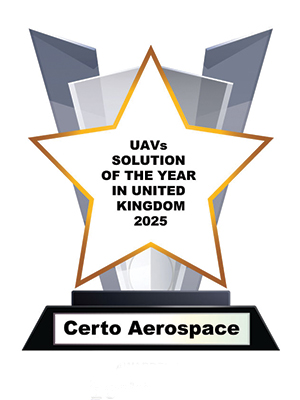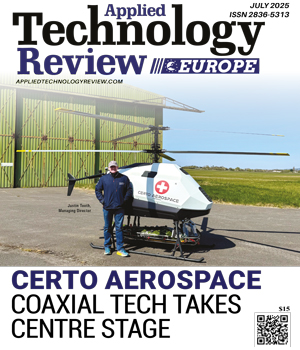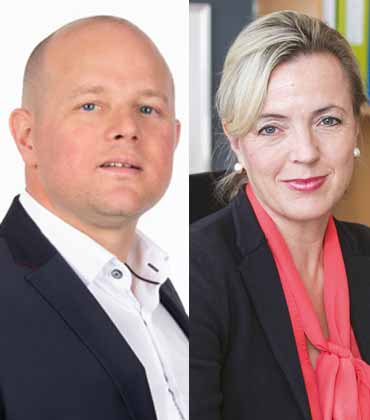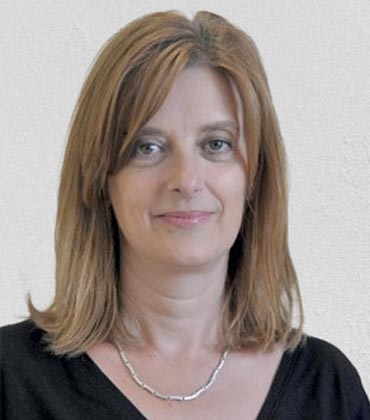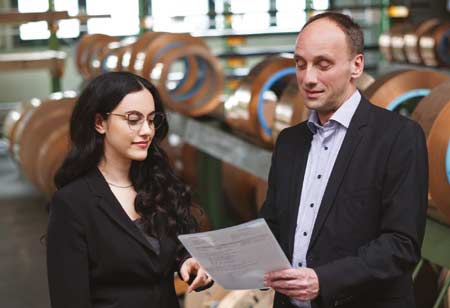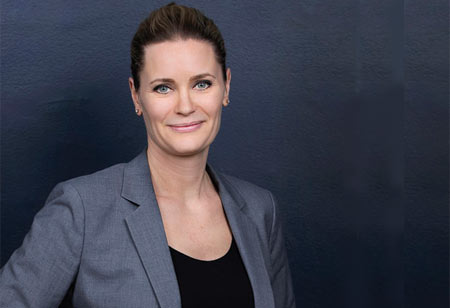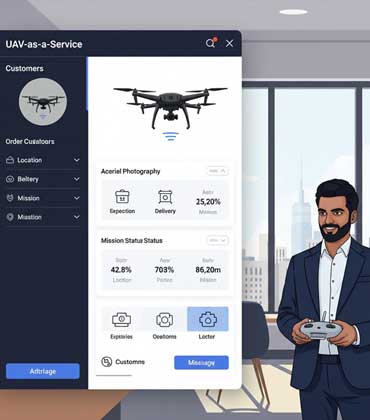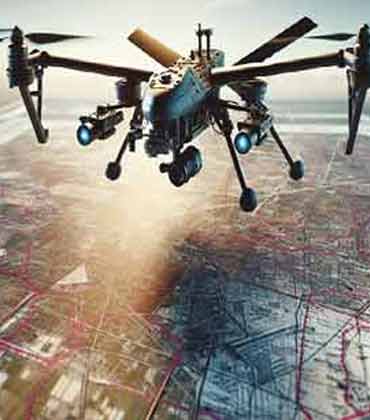THANK YOU FOR SUBSCRIBING
Applied Technology Review: Specials Magazine
The fundamental aeromechanics for the majority of helicopters have remained unchanged since Igor Sikorsky’s VS300 first flew in 1939. The single main rotor provides lift and control, whilst the tail rotor counteracts torque, preventing the helicopter from spinning uncontrollably. Certo Aerospace has gone an alternative route, with two large, contrarotating rotors on the same axis (“coaxial”) dispensing with the tail rotor, thereby eliminating both 15 percent energy loss and the risk of serious failures in the tail rotor system. With a design ethos of simplicity and reliability, this coaxial approach avoids other inherent pitfalls of multi-rotor and tandem aircraft, such as rotor inefficiency, control complexity, and larger aircraft size. Certo’s CAPSTONE has a dry weight of 300kg but can lift another 300kg as fuel and payload, giving an impressive one-to-one ratio and a Maximum Take-Off Weight of 600kg. High-Flying Efficiency Meets Dynamic Payload Performance This exceptional performance results from the proprietary coaxial rotor head integrated with a high power-to-weight internal combustion engine using liquid fuels such as petrol and diesel. These standard fuels contain at least 20 times more energy per kilogram than the latest Lithium-Ion batteries, providing the payload, range, and endurance needed for realworld missions. “Uncrewed coaxial helicopter designs are a rarity, making our approach generally very distinctive.” says Justin Tooth, Managing Director. “However, we think coaxial is the logical choice, all things considered. And because we have cyclic and collective swashplates on both rotors, CAPSTONE has a uniquely powerful ability to generate lift with precise airflow vectoring for control in windy conditions or operating to the decks of naval ships.” With that working payload capacity of 300kg, CAPSTONE can transport a wide range of logistics payloads or mission packages driven by plentiful onboard electrical power. Trading payload for fuel enables lighter payloads to be carried further (up to 500km) or for longer (up to 8 hours), allowing operators to match CAPSTONE capabilities to specific mission objectives, including humanitarian assistance. Smart Design Delivers Mission Flexibility and Reliability The Modular Open Systems Approach (MOSA)—which encapsulates the use of modular design, modular interfaces, and conformance to open standards—underpins Certo’s scalable design. CAPSTONE can be easily reconfigured with alternative Command and Control systems (C2), BVLOS navigation, automatic take-off and landing systems, and mission equipment packages.
Test Infrastructures For Unmanned Aerial System
AIRlabs Austria is a leading innovation laboratory for unmanned aerial vehicles, funded by the Austrian Ministry for Climate Action, positioning itself as a one-stop shop for drone innovation. Located in Graz and with four test facilities in Austria, the company offers comprehensive support along the entire value chain, encompassing research and development (R&D), testing and validation, as well as integration and certification of aerial vehicles. The company provides a unique testing infrastructure, including a multi-site concept that covers multiple terrains, such as alpine, wooded, and urban environments, for testing under various conditions. AIRlabs’ infrastructure, along with a team of highly specialised scientists and technicians helps customers secure necessary permissions and flight planning, as well as identify suitable partners for their innovation projects. “We offer support in infrastructure along the entire value chain—from R&D to testing and certification,” says Roswitha Wiedenhofer-Bornemann, Managing Director at AIRlabs. The company has collaborated with Austro Control and BMK to develop airspaces in various locations nationwide. AIRlabs manages and isolates airspaces that are solely dedicated to drone testing. This distinctive approach establishes a secure testing environment that reduces the potential for collisions with other aircraft, elevating overall safety throughout testing procedures. Committed to advancing drone innovation, the firm operates on a structured framework of six levels, each tailored to address specific technology readiness levels (TRLs). At operating level 1, AIRlabs focuses on the foundational aspects of unmanned aerial systems (UAS) R&D. This stage delivers a comprehensive suite of engineeringand simulation services that are housed within cutting-edge research infrastructures. From conceptualising thematic test scenarios to modelling, simulating and visualising various elements, including single and multi-UAV flights, avoidance routines and addressing icing challenges, the company covers it all.
Smart Aquatic Monitoring Solution
Water quality is fundamental to the health of aquatic ecosystems and the sustainability of aquaculture operations. In these environments, maintaining appropriate nitrogen levels is important as they influence water quality and, consequently, the health of aquatic life. Nitrogen Sensing Solutions, a deep-tech startup focused on the development of cutting-edge sensing systems, stands out with its mission to deliver functional water quality testing solutions. Its monitoring technology detects and measures the levels of nitrogen compounds in water and provides the results in real time on smartphones, tablets and dashboards. Combining ease of use with precision and mobility, Nitrogen Sensing Solutions’ tools help clients maintain optimal water conditions and support sustainable aquaculture practices. “Our primary focus is on monitoring nitrogen-based nutrients in aquatic ecosystems, which are crucial for both environmental and industrial applications,” says Gabriela Almeida, CEO of Nitrogen Sensing Solutions. Excessive levels of nitrogen compounds like ammonia, nitrites and nitrates can devastate aquatic ecosystems, posing risks such as stress, growth inhibition and even mass fatalities among fish populations. Nitrogen Sensing Solutions’ monitoring systems avert such catastrophic outcomes. The company stands out with its technological capabilities, duly exemplified by its innovative use of biosensors that integrate natural elements to achieve remarkable accuracy, specificity and selectivity in detection. These sensors are engineered for easy deployment and seamless integration with various systems.
CXO INSIGHTS

The Future of Human Interaction with Consumer Electronics: Meeting the Sensor Needs
Neomar Giacomini, Industry Partnerships - Advanced Development and Innovation, Whirlpool [NYSE: WHR]

Mental Health Under Construction (Of Site Set-Ups!)
Deniz Kayimbasioglu, Design Manager, Overbury
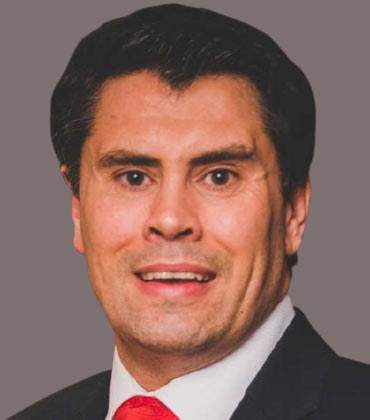
Revamping the Future of CNC Machining Space
Alex Rose-Parfitt, Engineering Director, Raytheon UK

Plotting the IT Roadmap for ERP
Christian Bayer, Head of Enterprise Applications & Delivery, Syngenta

Making Innovation Accessible in Rehabilitation Technology and Practices
Louis Martinelli, Winchester Physio & Aquatic Service Lead, Hobbs Rehabilitation
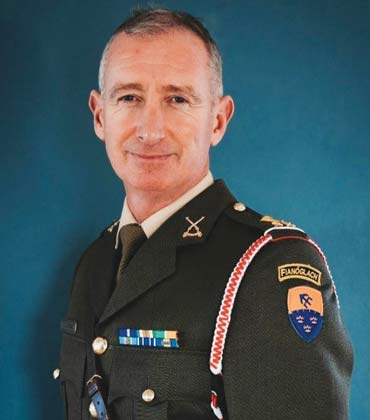
The Evolving Landscape of Irish Military Logistics
Colonel Gareth Prendergast, Head Of Strategic Force Design, Irish Defence Forces

The Main Challenges of Romanian Farmers Producing Potatoes
Alex Lazar, Agricultural Manager, Intersnack Romania
IN FOCUS
Harnessing Drone Technology: The Shift to UaaS in Europe
Europe is embracing UAV-as-a-Service, enabling flexible drone use across industries through a harmonised regulatory framework and technological advancements.
The Ascendance of Unmanned Aerial Vehicle Solutions in Europe
The European UAV industry is experiencing rapid growth, projected to attain USD 17.20 billion by 2034, driven by demand for automation and technological advancements.
EDITORIAL
Defining New Standards in Unmanned Systems
Unmanned Aerial Vehicles (UAVs) have evolved from experimental technologies into indispensable tools across multiple sectors. From environmental monitoring and infrastructure inspection to defence, logistics, and emergency response, UAVs are reshaping operational possibilities. Among the growing array of offerings, the most advanced UAV solutions distinguish themselves not merely by flight performance but by the depth of intelligence, adaptability, and integration they bring to each mission. Leading UAV platforms today are defined by their capacity to operate reliably in complex and demanding environments. These systems go beyond traditional aerial surveillance, offering multi-sensor payloads, extended endurance, and autonomous capabilities that reduce human workload while increasing mission efficiency. Their design reflects a clear shift from standalone drones to holistic systems that collect, process, and deliver actionable data in real-time. Seamless integration remains the foundation of top-tier UAV solutions. The most effective platforms are designed to integrate seamlessly with data analytics tools, cloud-based systems, and broader operational frameworks. This interoperability ensures that UAVs are strategic components within a larger decision-making ecosystem. Equally significant is the focus on user-centric design. The most respected UAV solutions strike a balance between technical sophistication and operational accessibility, enabling deployment by users without extensive aviation expertise. Through intuitive interfaces and automated workflows, these platforms democratise access to aerial intelligence. Above all, what sets top UAV solutions apart is their strategic alignment with specific industry needs. Whether supporting precision agriculture, enabling rapid disaster assessment, or enhancing situational awareness in defence scenarios, these systems are purpose-built and mission-driven. Their flexibility and scalability ensure they can meet current demands and future challenges. In an era where speed, precision, and intelligence define success, UAVs are essential. The leading solutions in this field are redefining the boundaries of aerial capability while setting new standards for how technology serves critical operations on the ground. In this edition, we examine how innovations in air-based intelligence and the advancement of UAVs are redefining operational effectiveness across sectors. The magazine highlights top UAV solution providers that are paving the way for a smarter, more connected future in transportation, infrastructure, and public safety. We also present insights from expert CXOs like Dr. Andreas Frehn, Director Technology & Innovation and Technical Marketing EMEA, Materion and Emmy Pavlovic, CTO, Bulten Group, who offer their opinions on the currently used business practices. We hope that the valuable insights from industry leaders and the solutions and services featured in this edition will assist you in making informed decisions for your business.



